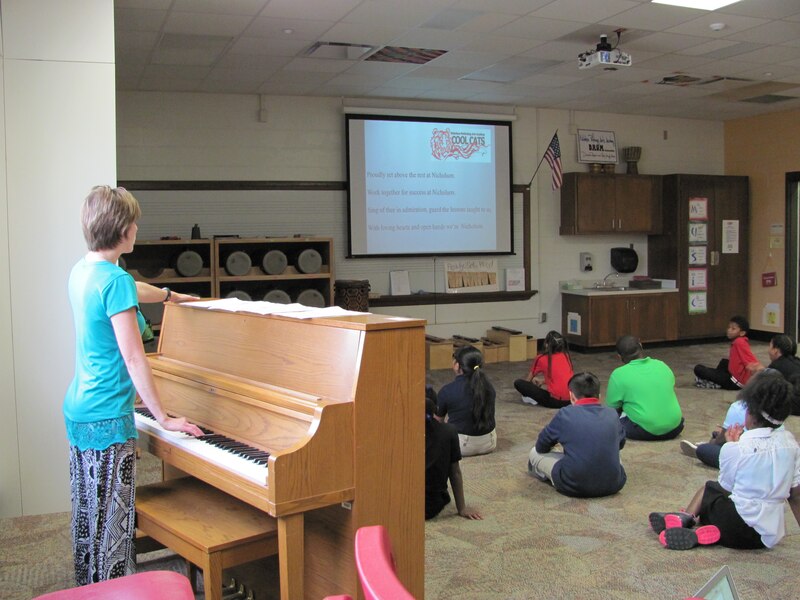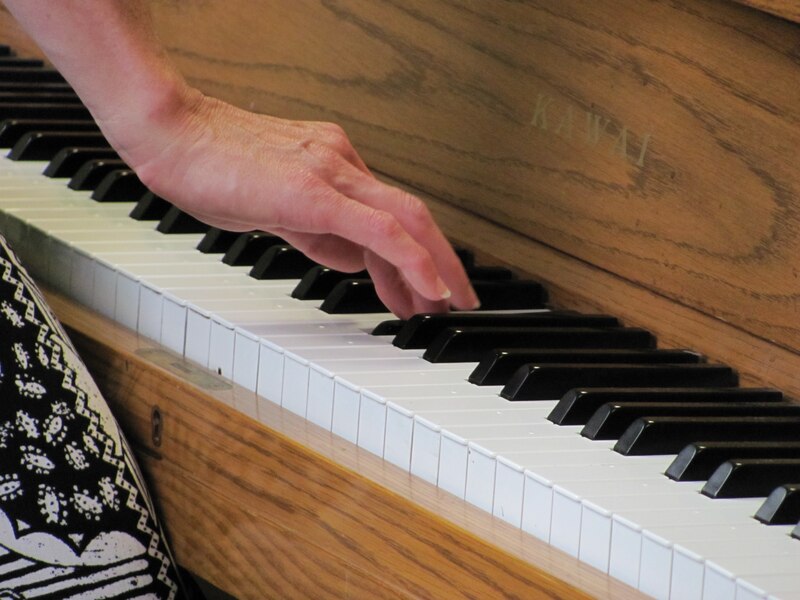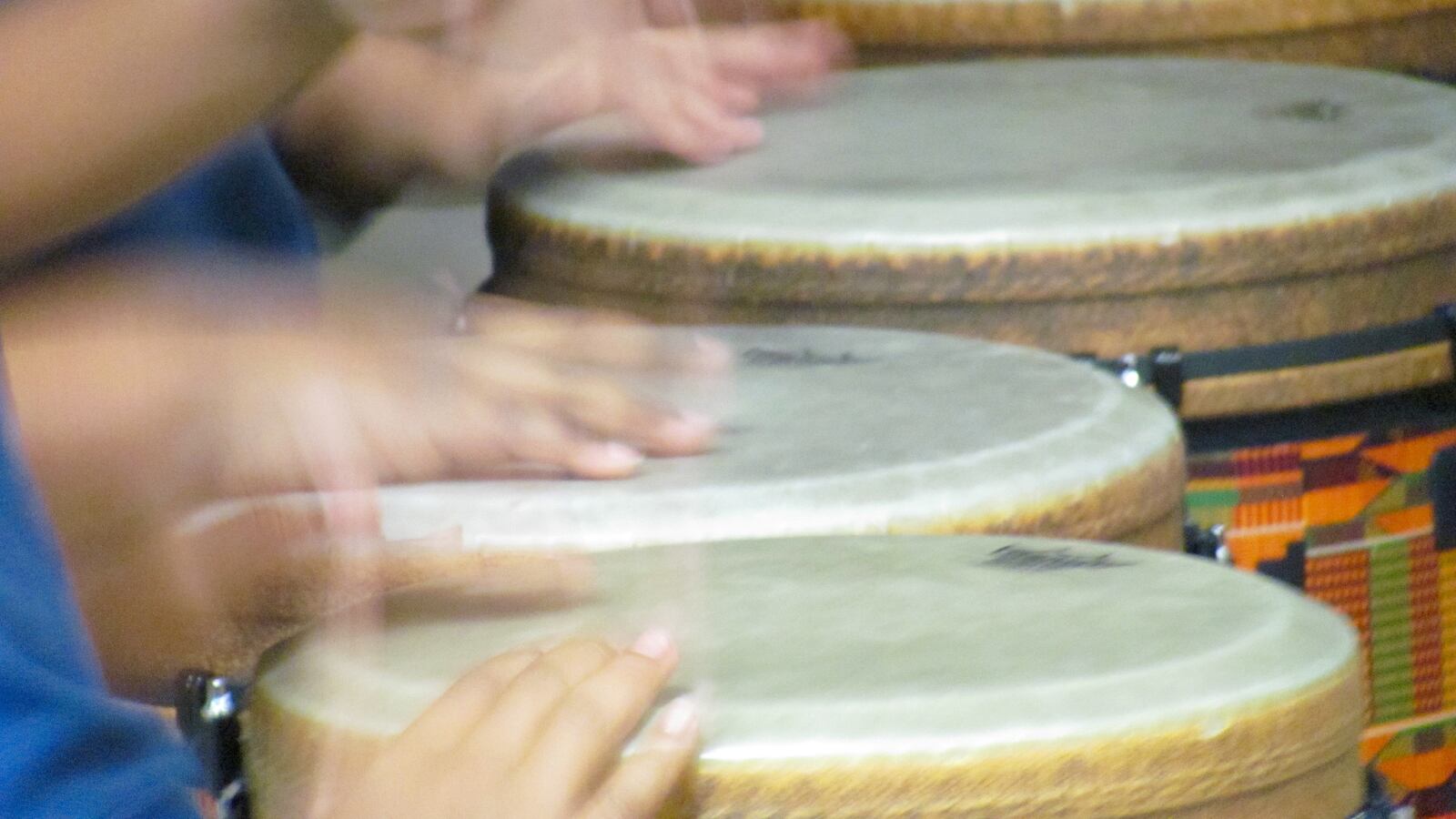Hulk, Batman, Superman, Wonder Woman.
What seems like a simple list of superheroes from rival comic book publishers turns into a lesson on rhythm and musical notes in Amber Price’s fourth-grade music class at Indianapolis Public School 70.
“Batman, Batman, Superman, Batman, Batman, Batman, Wonder Woman, Hulk!” the kids chant, falling into a sing-songy cadence as Price keeps time by hitting a tall, African drum at the front of the room.
It’s fun, and the kids love it, but Price has a stealth purpose: meet Indiana standards by using superhero names to get kids to understand music notes.
Price tells the kids the name of each comic book character is also a music note: “Hulk,” with just one syllable, or beat, is a quarter note. “Batman,” with two beats, is two eighth notes. “Superman” is three uneven beats, or one eighth note and two sixteenth notes. And “Wonder Woman,” with four quick beats, is all sixteenth notes.
Soon, the kids are chanting, clapping, stomping and snapping their fingers as they recite the whole song. It’s a noisy, lively lesson, and once the kids get instruments, Price can barely be heard above the din of drums, tambourines, maracas and mallets hitting wood blocks.
She continues to conduct at the front of the room, leading the class to the end of the song with a loud “HULK!” and a flourish of her arms to silence them.
When the kids leave for their next class, filing out quietly in two lines, Price exhales. It might take a lot of energy, but she’s just that much closer to crossing one more fourth-grade academic standard off her list: “Superman,” or rather, teaching her kids to read and interpret an eighth note attached to two sixteenth notes.
Indiana has seen rapidly changing standards in English and math. The standards were first revised in 2009, then the state made a switch instead to nationally shared Common Core standards and then it made one more change to the new Indiana-created standards that followed in 2014. That last change was a big battle between Common Core supporters and skeptics of the shared standards.
But expectations for what kids should be learning in art and music have stayed the same since 2012, said David Newman, the arts curriculum director for Indianapolis Public Schools. Even so, teachers and schools are doing things differently to keep pace with other subjects.

Newman, formerly principal at School 70, a fine and a performing arts magnet school, is trying to emphasize to his teachers that the arts can’t be taught in isolation from core subjects such as English, math, science and social studies, echoing moves he made at School 70.
“You can’t sit on your hands and have everything come to you and you do your little music and art things and you are not fused to anybody else,” he said. “What we did was we did fine arts collaboration in the classroom. We use fine arts in everyday curriculum.”
Connecting arts to classroom learning
Unlike core subject teachers, Price said IPS doesn’t provide her with a curriculum.
She uses her own training in strategies that combine music, movement and literacy to figure out how to make sure her kids know what is expected by the state.
“Everything is written for classroom teachers, what standard to do and lesson to do,” Price said. “I’m not given anything by textbooks, which I don’t really use. I don’t want them to sit there singing out of a book. I want them to read music, to write music and be able to enjoy playing music.”
Most students in IPS have art and music class about twice per week, usually for an hour or so total. That’s not a huge amount of time, Newman said, and though teachers have multiple classes and sometimes multiple schools, they also need to be working with core subject teachers to “push-in” to classroom lessons and show how the subjects are connected.
“Go to the teachers and say, ‘Hey, I see you’re studying Day of the Dead (a Mexican holiday) in first grade. I know some songs or we can create masks,’” Newman said. “Put yourself in there.”
That philosophy drove how he structured one program in partnership with the Indianapolis Philharmonic Orchestra. Former teachers wrote lessons aimed at third-graders, and all grade level teachers participated. The kids learned about composers and their compositions, and after a few months the classes and their teachers got to see the orchestra play the music they’d been learning about.
Price said she teaches songs in her music class that can apply to English or math, such as a song about prepositions. Classroom teachers might also have students act out their reading for the day instead of just reading their chapters from the book. The key is finding small ways to infuse the arts into other areas, she said.
Cindy Huffman, curriculum director in Pike Township, said all performing arts standards have literacy components in them, so when the state transitioned toward Common Core, and then to new standards a year later, the district talked with teachers about how to make sure those standards were taken into account in all subjects — even the arts.
For example in sixth grade, students might be asked to determine the main idea of a piece of music and summarize it — an English standard for written passages — or identify important details and write about the style of art an artist chose. Just like with core subject teachers, performing arts teachers also had to develop tests and growth measurements so their instruction can be assessed, she said.
“All the teachers have been involved in the entire movement to Common Core as well as the Indiana Academic Standards, to those higher-level thinking and asking higher-level questions,” Huffman said.

Music and math, for example, are already heavily linked, Newman said. Music notation uses fractions in deriving musical notes, beats and rhythms. Price’s superhero lesson, for example, reinforces the concept of fractions in beats. Connecting music to English can happen through poetry, song lyrics and even history, he said. Integrating fine arts and traditional classroom subjects, Price said, really enhances both lessons.
“It makes it more fun, I think, for learning really, instead of just sitting there with your paper and your pencil,” Price said. “You’re up moving, you’re having fun singing and stuff like that. I learned the preposition song in sixth grade, and I can still sing it — It does help with remembering.”
The wider arts community offers support
It’s not just teachers who try to find innovative ways to connect arts and classroom studies. Schools also depend on outside partners for help.
For example, The Indianapolis Museum of Art can equip teachers to use visual and performing arts strategies in their classrooms.
This year, the museum started a STEAM club — science, technology, engineering, arts and math — that pairs traditionally disparate subjects. Four teachers-in-training from Butler University and six Indiana teachers are part of the group learning to integrate those strategies in their teaching.
“Too often we compartmentalize learning,” said Heidi Davis-Soylu, who oversees the museum’s education initiatives. “For a long time in the history of education, it wasn’t like that. There wasn’t ‘the sciences’ and ‘the arts’ — they were together.”
For now it’s just a pilot program with 10 teachers, but the museum also offers summer training workshops for teachers who want to learn more about the arts. There are also materials and other training programs available that support Indiana’s new academic standards.
Davis-Soylu, a former teacher who later went back to school to study art education, said kids, especially younger ones, can learn a lot from experiencing art alongside typical core subjects.
Hands-on activities can teach them to fine-tune motor skills and help them become better problem-solvers, she said. There’s not just one right answer in music or art, like on a standardized test.
“They are not trying to have to get to A, B, C or D,” she said. “And that just challenges the mind and gives opportunities for critical thinking.”
For older students, she said, developing more ways to express themselves and build on basic artistic skills learned in elementary school can help them discover their own voices. It also offers an avenue for building community and could motivate kids to learn more about the culture that surrounds them, Davis-Soylu said.
She cited research that found that those who participated more in the arts actually were better citizens — they voted more and had higher levels of education. Plus, she said, there are few downsides to being exposed to other cultures and types of expression.
Academic standards provide a framework for that experiential learning, Newman said, but it’s challenging for teachers when they have so little time with each class. It can be almost impossible to cover both the “performance” standards — literally whether they can “do” the art well, such as by playing an instrument competently — and the ones about theory or history, he said.
“Understanding music in relation history and culture and why it’s important, where things came from and how music and art shaped history, you know, we don’t get to talk about that enough,” Newman said. “People like to use time as an excuse — I’m just as guilty as anybody — but you have to think past that.”
Price, for example, has just 37 class sessions with her students. That means she has to make the most of what she has. She focuses less on history except when it corresponds with another teacher’s lesson, but she does very clearly outline the music-reading goals she has for each grade level she works with.
Theory is especially important to what “college- and career-ready” standards, like those Indiana has adopted, make a focal point: critical-thinking, problem-solving and question-asking skills.
“Teachers need to understand: You aren’t just teaching music, you aren’t just teaching art, you aren’t just teaching social studies. You don’t teach in isolation either,” Newman said. “Some of (the standards) are pretty powerful, and if you can use them and address some topics, you can also support social studies and math and science, which I think is better for everybody.”


